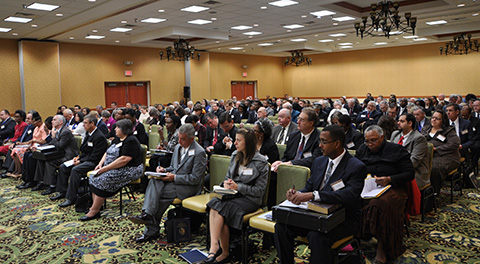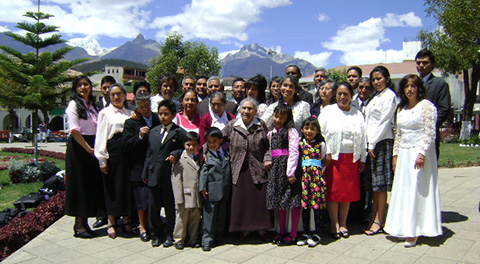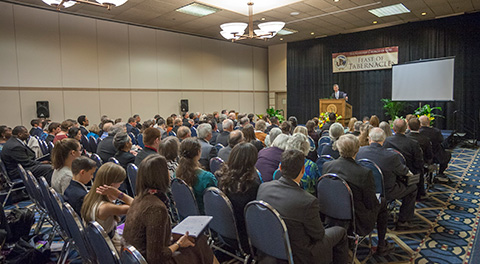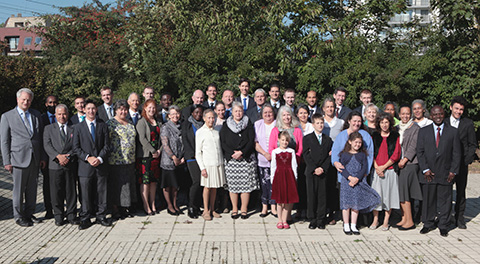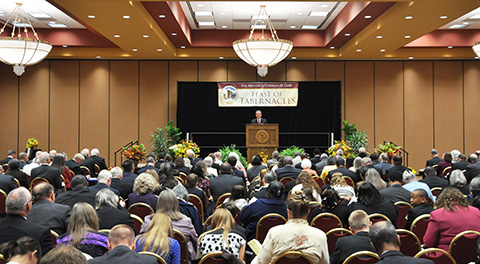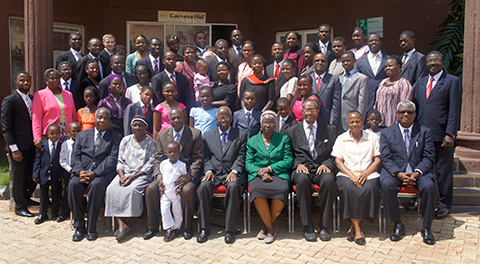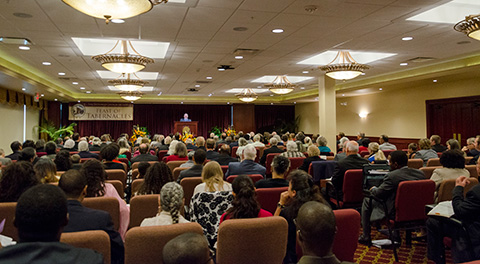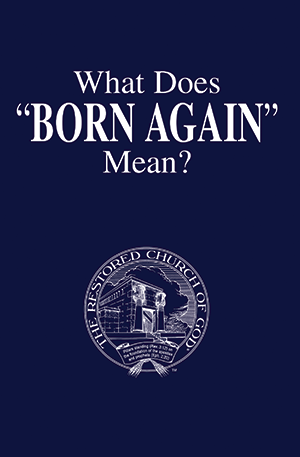To many people, the word “angel” conjures up images of winged, harp-playing, halo-endowed, perhaps mischievous beings romping around on clouds. Images and statues of angels (as envisioned in the minds of men) are found almost everywhere—in churches, books, magazines, greeting cards, etc. Angels have also been popular subjects in films, television and music. They are often portrayed as emotional entities having common human frailties. These and other such misconceptions serve to terribly blur the purpose for which God created angels.
Today, there are perhaps as many wrong concepts of angels as there are church denominations. As with most spiritual matters, people generally accept and believe, without question, what they hear preached from the pulpit.
Why? Because most ministers in this world only preach what they know their congregations want to hear. (Notice Ezekiel 13.) The god of this world, Satan the devil (II Cor. 4:4), has blinded the world to God’s Purpose. This includes the truth about angels, as well as the ultimate role that human beings can have in God’s Plan.
To begin to understand who and what angels are and their role in God’s Plan, notice Hebrews 1:14: “Are they [angels] not all ministering spirits, sent forth to minister for them who shall be heirs of salvation?”
Who are the “heirs of salvation”? Romans 8:16-17 provides the answer: “The [Holy] Spirit itself bears witness with our spirit, that we are the children of God: And if children, then heirs; heirs of God, and joint-heirs with Christ; if so be that we suffer with Him, that we may be also glorified together.” Christians are those called by God (John 6:44, 65) to one day “inherit all things” (Rev. 21:7).
So then, angels are spirit beings with greater knowledge and power than human beings (II Pet. 2:11), created for the purpose of assisting those called and begotten by God. (To learn more about what it means to be spiritually begotten, read our free booklet What Does “Born Again” Mean?) The Greek term translated “to minister,” in Hebrews 1:14, is leitourgeo, meaning “to worship, obey, relieve.”
Also notice the apostle Paul’s words in I Corinthians 6:3: “Know you not that we shall judge angels?” When placed together, these verses show that angels serve God’s people now and will also serve and answer to them in the future.
Hebrews 2 sheds even more light on the relationship between angels and mankind: “For unto the angels has He not put in subjection the world to come, whereof we speak. But one in a certain place testified, saying, What is man, that You are mindful of him? Or the son of man, that You visit him? You made him a little lower than the angels; You crowned him with glory and honor, and did set him over the works of Your hands: You have put all things in subjection under his feet. For in that He put all in subjection under him, He left nothing that is not put under him. But now we see not yet all things put under him. But we see Jesus, who was made a little lower than the angels for the suffering of death, crowned with glory and honor; that He by the grace of God should taste death for every man” (vs. 5-9).
This article will examine many common misconceptions concerning angels and show the truth from God’s Word.
Begin at the Beginning
To understand the origin of angels and God’s purpose for them, the place to start reading is where their first appearance
is mentioned in God’s Word. The Bible is like a jigsaw puzzle; the pieces (“here a little, there a little”—Isaiah 28:10) fit together to form a complete picture. The first time we find angels mentioned in Scripture does not necessarily indicate their first arrival on the scene.
One scripture that provides a key to unlocking the mystery is found in Job chapter 38. There, we find “the Lord” (the One who later became Jesus Christ) asking Job a series of “Where were you…” questions. This was done to bring Job to an understanding of his “importance” in the overall scheme of things. Notice verse 7: “[Where were you] when the morning stars sang together, and all the sons of God shouted for joy?”
This verse reveals that the ones referred to as “morning stars” and “sons of God” existed prior to the creation of the physical universe. God created angels long before He created the earth. It also shows that, prior to Lucifer’s rebellion, there was unity among the angels.
God is not the author of confusion (I Cor. 14:33), and His word does not return to Him void—empty-handed (Isa. 55:11). Isaiah 45:18 sheds even more light on the subject: “For thus says the Lord that created the heavens; God Himself that formed the earth and made it; He has established it, He created it not in vain, He formed it to be inhabited: I am the Lord; and there is none else.” Also notice that God says that Lucifer, who later rebelled and became Satan, was “perfect in your ways from the day that you were created, till iniquity was found in you” (Ezek. 28:15). This shows that Satan (originally called Lucifer) was not created a devil. He rebelled, and became Satan the devil. (Notice Isaiah 14:12-15.)
“Sons of God”
As in Job 38:7, other scriptures refer to angels as “sons of God,” who appear before God’s heavenly throne (Job 1:6; 2:1). These verses cannot be talking about mere physical human beings. Notice John 3:13: “And no man has ascended up to heaven, but He that came down from heaven, even the Son of man which is in heaven.” Angels are called God’s sons because He created
them, not because they were begotten of God, as was Christ, “the firstborn among many brethren” (Rom. 8:29).
Many read Genesis 6:1-2 and conclude that this scripture is also talking about angels: “And it came to pass, when men began to multiply on the face of the earth, and daughters were born unto them, that the sons of God saw the daughters of men that they were fair; and they took them wives of all which they chose.”
According to pagan mythology, men of normal human physical form, but “god-like” in strength and ability (Hercules, Achilles, etc.), were born as a result of angels (“sons of God”) marrying human women. Of course, this is false—these could not have been angels, because Mark 12:25 plainly says angels do not marry!
In verse two, “God” should be god (small “g”). These were not angels, nor even God’s people (who, as Christians, are begotten sons of God). Rather, these were sons of this world’s god (II Cor. 4:4). It is important to note that they were not his sons through any kind of physical lineage, but by virtue of their obedience to him (see John 8:44). History shows that an apostasy occurred at this time, led by Methuselah and Lamech, Noah’s grandfather and father. Only Noah held fast to God’s Way.
How Many Angels?
After creating the earth, God put Lucifer, one of three archangels, in charge of caring for and tending it. Lucifer was, as God puts it, “…the seal of perfection, full of wisdom and perfect in beauty…perfect in [his] ways from the day [he was] created…” (Ezek. 28:12, 15, New King James Version). Verse 15 continues, “…Till iniquity was found in [him].” Lucifer went bad. He sinned—rebelled against God and His government. During this insurrection, he drew away with him one third of all the other angels (Isa. 14, Jude 6, Rev. 12:4). After this rebellion, God changed Lucifer’s name to Satan—meaning “destroyer or adversary.” All of the fallen angels then became known as demons. Since the creation of man, Satan and his demons have sought to destroy human beings and to thwart God’s plan of reproducing Himself.
Before going any further, let’s do some math. No one knows for sure how many angels were actually created. The Bible is not absolutely clear on this. However, Revelation 5:11 states, “…ten thousand times ten thousand, and thousands [plural] of thousands [plural].” The Adam Clarke Commentary says, “Myriads of myriads and chiliads of chiliads;” means “…an infinite or innumerable multitude.” Then Clarke references a similar saying in the book of Daniel.
In Barnes’ Notes, Albert Barnes says of Daniel 7:10, “The mind is stuck to the fact that there are thousands present—and then the number seems as great as if those thousands were multiplied a thousand times. The idea is that there was an immense—a countless number” (“Daniel,” vol. 2, p. 60).
Now let’s multiply this equation from Revelation and see how immense this number could be:
10,000
x 10,000
100,000,000
countless millions* (*“thousands of thousands”)
At least hundreds of millions! Can you grasp this? And this is just the number of faithful angels! (Remember, Revelation 12:4 states that one third of the angels rebelled.) Now, if over one hundred million is two-thirds of the total number of angels, then that would bring the grand total, of good and bad angels, to over one hundred and fifty million, at the most conservative estimate. (This is by no means established doctrine, only an estimate to give a general idea of the numbers involved.)
Cherubim, Seraphim and the Four Living Creatures
While Scripture does not describe all angels in detail, two types of angels the Bible speaks of are cherubim and seraphim.
Cherubim were placed just outside the Garden of Eden to prevent mankind from re-entering it after Adam and Eve sinned (Gen. 3:24).
In Ezekiel, we find a description of cherubim—“four living creatures,” actually one being who had four faces and four wings (1:5). One face was that of a man, another was a face of a lion, then a face of an ox, and finally a face of an eagle (1:10).
In Ezekiel, chapters 1, 9 and 10 show that one of their functions is to support and transport God’s throne. Exodus and Leviticus also provide a description of these beings’ position at God’s throne, since the physical tabernacle that God instructed the Israelites to build and take with them as they journeyed represented His heavenly throne.
These four living creatures were specially created beings that support the four corners of the platform or “firmament” upon which God’s throne rested. Four gyroscopic-like devices (“a wheel in the middle of a wheel”) were also on the four sides of the platform which “turned not when they went” (vs. 16-21). These could have been similar to any physical gyroscope used to stabilize a ship or in a jetliner’s guidance system. These beings were the same ones referred to by the apostle John as the “four beasts” of Revelation 4:6.
The seraphim were also created for a specific purpose. The term “seraphim” is mentioned only in Isaiah 6:2-6. Each has six wings and apparently the face of a man. Isaiah 6:2 states, “Above it [God’s throne] stood the seraphims…” These are the two cherubim mentioned in I Kings 6:23 and II Chronicles 3:10-13.
Understanding that the cubit below refers to the long cubit of 25.2 inches, we have these facts: “And in the most holy house he made two cherubims of image work, and overlaid them with gold. And the wings of the cherubims were twenty cubits [over forty feet] long: one wing of the one cherub was five cubits [over ten feet], reaching to the wall of the house: and the other wing was likewise five cubits, reaching to the wing of the other cherub. And one wing of the other cherub was five cubits, reaching to the wall of the house: and the other wing was five cubits also, joining to the wing of the other cherub. The wings of these cherubims spread themselves forth twenty cubits: and they stood on their feet, and their faces were inward” (II Chron. 3:10-13).
Unger’s Bible Dictionary speculates that these cherubim were ten cubits (over twenty feet) tall and stood upright as a man, which may be compatible with the proportions above. II Chronicles 3 describes these cherubim as they appeared in Solomon’s temple. With each wing spanning ten feet, one resting against the wall and the other wing covering the mercy seat in the center of the Holy of Holies, each of these beings had a wingspan of twenty feet. Both together spanned the entire room of forty feet. Each of these magnificent beings had a total of six wings.
We cannot say for certain that these representations of Solomon’s temple reflect the actual size of these powerful beings, but this may have been the case.
Archangels
Cherubims are special, powerful “archangels.” (Notice Ezekiel 28:14.) The Bible speaks of three such beings—Michael, Gabriel and Lucifer (who later rebelled, becoming Satan the devil – vs. 15). Each rules one-third of the angelic realm (Rev. 12:4).
Ezekiel 28:14 indicates that, before his rebellion, Lucifer was “the anointed cherub that covers.” He was apparently one of these two beings [cherubim] before being dispatched to Earth with one third of the angels under him. Since these particular cherubim were called seraphim, it could be that the seraphim mentioned by Isaiah were similar to archangels.
Michael is referred to as “one of the chief princes” (Dan. 10:13); “your prince” (vs. 21); “the great prince which stands for the children of your people” (12:1); and “Michael the archangel” (Jude 9). He was given the responsibility of protecting and ministering to the twelve tribes of Israel (Dan. 10:13, 21).
Scripture shows that Gabriel serves mainly as a messenger to God’s people. Notice Daniel 8:16; 9:21 through chapter 10; Luke 1:19, 26.
Angels Appearing as Men
Many biblical accounts of angels physically manifesting themselves to God’s people show that they appeared as men. For example, Genesis 18 describes a time when three “men” (vs. 1-2) visited Abraham. One of them was the “Angel of the Lord”—and the other two were angels appearing as men. Later, the Angel of the Lord stayed behind with Abraham, and the two angels went ahead to the city of Sodom.
Notice the continuation of the account in Genesis 19:1: “And there came two angels to Sodom at even; and Lot sat in the gate of Sodom: and Lot seeing them rose up to meet them; and he bowed himself with his face toward the ground.” These two are again referred to as men in verse 5, in which the perverted citizens of Sodom accosted Lot, demanding that he turn his guests over to them.
In the New Testament, we also find angels appearing as men. When comparing Matthew 28:5 and Mark 16:5, we see an individual described both as an angel and as a “young man” appearing to Mary Magdalene and Mary, Zebedee’s wife. This account is also depicted in Luke 24:4 (which describes those who waited at Christ’s tomb as men), and John 20:11-13 (describing them as angels).
How important are these beings? Hebrews 13:2 states, “Be not forgetful to entertain strangers: for thereby some have entertained angels unawares.” In other words, when involving themselves in human affairs, angels do not always (if ever) make it known that they are angels. Paul’s instruction shows the manner in which we are to respond to those who entreat our hospitality—we should act as if they were God’s own spiritual messengers. Our treatment of these “strangers” may have a direct bearing on the extent to which we receive angelic protection and intervention.
Also, it is interesting to note that, contrary to popular concepts of angels being in the form of women or babies, Scripture always describes their appearance as that of men.
Who is “the Angel of the Lord”?
Various Old Testament scriptures refer to “the Angel of the Lord”—but who is this being?
Notice Exodus 14:19: “And the angel of God, which went before the camp of Israel, removed and went behind them; and the pillar of the cloud went from before their face, and stood behind them.”
Exodus 13:21-22 clarifies the identity of this Being: “And the Lord went before them by day in a pillar of a cloud, to lead them the way; and by night in a pillar of fire, to give them light; to go by day and night: He took not away the pillar of the cloud by day, nor the pillar of fire by night, from before the people.”
Notice I Corinthians 10:1-4: “More-over, brethren, I would not that you should be ignorant, how that all our fathers were under the cloud, and all passed through the sea; and were all baptized unto Moses in the cloud and in the sea; and did all eat the same spiritual meat; and did all drink the same spiritual drink: for they drank of that spiritual Rock that followed them: and that Rock was Christ.” Christ was “the Lord”—the God of the Old Testament.
Together, these verses show that it was Christ who led the Israelites out of Egypt, through the wilderness and to the Promised Land.
An authoritative concordance describes this Being: “The ‘Angel of the Lord’ sometimes shares divine characteristics and is sometimes thought to be a manifestation of God Himself, or of the preincarnate Christ” (Strongest Strong’s Exhaustive Concordance of the Bible).
Genesis 22:11-12 states, “And the angel of the Lord called unto him out of heaven, and said, Abraham, Abraham: and he said, Here am I. And He said, Lay not your hand upon the lad, neither do you any thing unto him: for now I know that you fear God, seeing you have not withheld your son, your only son from Me.” This could not have been merely one of the created angels.
Angels Not to be Worshipped
The Bible shows that angels are not to be worshipped. Notice Revelation 22:8-9: “And I John saw these things, and heard them. And when I had heard and seen, I fell down to worship before the feet of the angel which showed me these things. Then said he unto me, See you do it not: for I am your fellow servant, and of your brethren the prophets, and of them which keep the sayings of this book: worship God.” (Also notice Revelation 19:10.)
The “Star in the East”
Another subject commonly misunderstood by most professing Christians is the “star in the east,” mentioned in Matthew 2:1-2. Many read this verse and mistakenly assume that the wise men from the east were following a literal star, marking the location of Jesus and His parents. (It is also commonly believed that there were three wise men, although Scripture does not indicate the actual number.)
Notice what these verses state: “Now when Jesus was born in Bethlehem of Judea in the days of Herod the king, behold, there came wise men from the east to Jerusalem, saying, Where is He that is born King of the Jews? For we have seen His star in the east, and are come to worship Him.”
It is important to note that these men had come from the east. The “star” they saw was also in the east. Therefore, they could not have been traveling from a place to the same place. These men had to travel west to arrive in Jerusalem. Otherwise, the reference to “from the east” would have no meaning.
Now read verse 9: “When they had heard the king, they departed; and, lo, the star, which they saw in the east, went before them, till it came and stood over where the young child was.” This could not have been a literal star.
Genesis 1:14 records, “And God said, Let there be lights in the firmament of the heaven to divide the day from the night; and let them be for signs, and for seasons, and for days, and years.” Some may read this verse and think that stars, which would be among the “lights in the firmament,” were created by God to serve as “signs.” They might therefore conclude that the men of the east were following a literal star. But verse 16 states, “…He made the stars also.” Stars were not created for signs.
To understand, we must allow the Bible to interpret itself. Again notice Job 38:7. Also read Revelation 1:20: “The seven stars are the angels of the seven churches…” Here, stars are plainly shown to symbolize angels.
Therefore, the “star in the east” was an angel given the responsibility of leading the wise men to Jesus.
What About “Guardian Angels”?
Another popular misconception concerning the angelic realm that has intrigued and confused many involves so-called “guardian angels.” Many read Acts 12:15 and conclude that each human being has a single “guardian angel” looking out for him personally. However, there is no evidence in Scripture that angels are “assigned” to us one at a time. Notice what the verse states: “And they said unto her [Rhoda], You are mad. But she constantly affirmed that it was even so. Then said they, It is his angel.” Why would they have said this?
Another vital key to understanding the Bible is to examine the context in which a verse is written. When people focus solely on a single verse, and ignore the context (as well as other related scriptures), they get off track in their understanding.
To understand Acts 12:15, first read the following verse: “For He shall give His angels charge over you, to keep you in all your ways” (Psa. 91:11; also notice Matt. 4:6; Luke 4:10). These scriptures establish that, at any given time, God’s people each have more than one angel serving to protect them.
It is also important to understand that we must meet certain conditions in order to have angelic protection. Notice I Corinthians 11:10: “For this cause ought the woman to have [a symbol of] power on her head”—why?—“…be-cause of the angels.” When a woman demonstrates a humble, submissive attitude, it sends a signal to the angels, giving them the responsibility to protect her. Notice Job 1:6; 2:1. In these verses, we see angels coming before God’s throne to receive their “marching orders,” as alluded to in Psalm 91:11.
The context of Acts 12 is that King Herod had taken the apostle Peter and imprisoned him. When the brethren heard Peter’s knock at the door, they were praying (vs. 12), no doubt for Peter’s release. Their reply to Rhoda was not due to a lack of faith, but was rather the reaction one would naturally expect from zealous people who had witnessed and endured much persecution. They had faith that Peter would be delivered, and that even death is a form of deliverance “from this present evil world” (Gal. 1:4; also notice II Tim. 4:6-8; Heb. 11:39-40).
During the apostolic era, interactions between Christians and angels were not uncommon. The New Testament records several accounts of this (Matt. 1:20; 2:19; 28:2-7; Luke 1:11-20, 26-38; Acts 5:19-20; 10:3-6; 12:7-9). Read Galatians 1:8: “But though we, or an angel from heaven, preach any other gospel unto you than that which we have preached unto you, let him be accursed.”
To further understand, notice Matthew 18:10: “Take heed that you despise not one of these little ones; for I say unto you, That in heaven their angels do always behold the face of My Father which is in heaven.” It is important to note the reference to “their angels,” those who watch over “these little ones.”
Again, the members of the Church would have understood this. Christ’s words in Matthew 26:53 further show this: “Think you that I cannot now pray to My Father, and He shall presently give Me more than twelve legions [72,000] of angels?” This is an astonishing number of angels that Christ had command of at any given time!
In Psalm 68:17, King David wrote, “The chariots of God are twenty thousand, even thousands of angels: the Lord is among them, as in Sinai, in the holy place.” This is another amazing statement concerning the number of God’s angels.
Also notice David’s words, in another reference to the “angel of the Lord,” in Psalm 34:7: “The angel of the Lord
encamps round about them that fear Him, and delivers them.” Whenever angels carry out their responsibilities, they are acting on behalf of the Father and Christ, and according to their express will and intent. In Psalm 34:7, David again demonstrated the number of angels that are loyal to God.
Since angels are always in God’s presence, there has to be, of necessity, a “rotation of duties.” But there is obviously more than one angel assigned to each person.
What We Can Understand Now
We cannot at this time know all there is to know about angels, just as we cannot now know every detail about events prior to man’s creation, or all the details beyond God’s 7,000-year Plan. There are many things we cannot know until we are resurrected as spirit beings into God’s Family (I Cor. 13:9-12).
But God’s Word provides all the vital information to make us “wise unto salvation” (II Tim. 3:15). In other words, it tells us all we need to know in order to “grow in grace, and in the knowledge of our Lord and Savior Jesus Christ” (II Pet. 3:18).
II Kings 6 provides a fascinating account showing the awesome role that angels have in the lives of God’s people. You may wish to read the entire chapter, especially verses 15 through 17.
This account shows that, as the prophet Elisha stated, “they that be with us are more than they that be with them [our enemies]…And the Lord opened the eyes of the young man; and he saw: and behold, the mountain was full of horses and chariots of fire round about Elisha” (vs. 16-17).
This shows that, as God’s servants, we have a vast spirit army on our side!
And, as I Corinthians 6:3 shows, true Christians will one day judge angels. As they now serve us, they are aware of the future responsibility that we will have, and that they are like regents, serving those who will one day be kings over them.
Therefore, as did Paul, we can say with confidence, “…neither death, nor life, nor angels, nor principalities, nor powers, nor things present, nor things to come, nor height, nor depth, nor any other creature, shall be able to separate us from the love of God, which is in Christ Jesus our Lord” (Rom. 8:38-39). This is a sure promise from God, which will not fail (II Pet. 1:4; Rev. 22:6).




